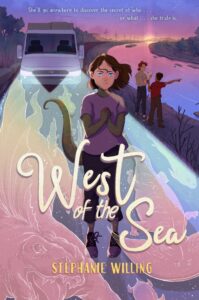by Stephanie Willing
If you were an early reader, it’s easy to imagine that all kids are like you—that they inhale books like air, figure out words by context clues (or look them up in the physical dictionary), and when they run out of new books, they re-read the old ones until the pages are falling out. But falling in love with reading does not always come easy! Here are five things we can do to meet kids where they are.
-
Literacy is ongoing.
Middle-grade books are written for kids ages 8-12, and anyone who has children or works with them can attest that is a huge developmental range. Some of them are still learning how to read! Right now, the middle-grade market is seeing a slowdown, and that is partly attributed to the disruption caused by the pandemic and how that has affected kids’ educations.
As an audiobook narrator, when I’m recording middle-grade fiction, I deliberately slow down my pace because I’ve learned that some children practice reading by listening and following along in a book at the same time. We can do the same thing in our writing by remembering who we’re writing for—it’s not us, it’s a kid out there who needs this story, and they need it accessible. Where can you be clearer? Sillier? Is that long, beautiful sentence you just wrote a way into your book-world, or did you just put up a gate that will keep kids out?
-
Shorter is better.
I say this as someone guilty of writing a long middle-grade novel (57k words): shorter is better. Short sentences, short chapters, short books. At least, that’s true for the market right now, and the many reluctant readers we want our books to reach. “Reluctant reader” is a term used to describe exactly what it sounds like—kids who, for many legitimate reasons, don’t want to pick up a book.
A smaller-sized book is less intimidating than a hulking tome. This is one reason comic books and graphic novels are such a boon to literacy and creating the next generation of book lovers. The illustrations help with context, and the action pulls kids along, and all the while they’re strengthening their reading and comprehension skills.
Shorter books are an easier sell to kids, parents, and to bookstores. In pure logistics, small books take up less space on a store’s shelves than big ones. As my first agent told me, “The more words you cut, the more I can sell it for.” While a general word count for MG is listed at 25k-50k, there are a lot of folks clamoring for more books in the 30k range. Cut those darlings!
-
Kids are dealing with the same stuff we are.
This is why I love middle-grade books so much. The challenging issues that come up when you’re a kid are the same things we’re still wrestling with as adults. Their stories center around family, grief, loss, making or losing friendships, injustice, and finding where you fit in your community. Even when a book is pure silly entertainment, there’s a feeling underneath it of someone looking around and saying, “The world is kinda weird, isn’t it?”
By way of contrast, Young Adult fiction (for ages 13-17), is so much about all of the firsts (first kiss, first job, first time taking down an evil empire with only your band of fellow teen misfits because your parents died in the prologue). And that’s delightful too!
In middle-grade, the realness and magic go both ways. A high-fantasy book is still going to center around family and daily life, and the most grounded, gritty contemporary story will have a sprinkle of stardust somewhere. Because they’re still kids, and where there are kids, there’s hope. It hasn’t been wrung out of them yet.
-
Write your/their wound.
When you’re finding the voice and story for your middle-grade characters, remember that they’ve been hurt. They have seen and heard and been told things that have given them misbeliefs that guide their choices. They’ve made choices they’re ashamed of, and there are things they don’t want to talk about. Dig into those places.
I have zero research to back this up, but I suspect an authentic kidlit voice comes from the times in our lives where something broke inside us. We didn’t heal quite right, and there’s a fragment of us locked in the shape of that moment.
And we all have traumas—they don’t have to be huge. It could be your best friend not catching you during a trust fall and then laughing at you when you cried about it, or that time you lost a spelling bee on an easy word the one time your dad took off work to see you compete. Remember? This stuff hurts. Just like the Rumi saying, “The wound is the place where the Light enters you,” our wounds can also let that kid-voice and kid-heart out.
-
These kids have phones. If yours don’t, you might be writing a period piece.
If you’re writing about kids in our world, and they don’t have internet or cell phones, you’re writing historical fiction. Ouch! I know—my elder millennial soul is doing a death roll. This fact makes writing mysteries soooo much harder because many problems can be solved with a simple internet search. You’re gonna have to get creative.
And talk to real kids! They don’t say “cell” or “cell phone.” It’s just “phone”—I was corrected by a teen beta reader. And last I heard, they hate emails (and phone calls, obviously). Phones are just for texts, videos, and social media. But who knows? It could be something else tomorrow.
There are workarounds of course. You could drop your characters on a mountain range with no reception, or they have to turn in their phones before they compete in an elite maze with only their wits and combat skills, or they’re home schooled in a community that believes the internet is evil.
If you’re writing a book that takes place in our world, there is a line in the time-sand, and your story is happening on one side or the other. You can’t pretend technology doesn’t exist.
Middle-grade books are often the bedrock of our literary lineage. What book did you read as a kid that still affects how you think about the world today? Share with us on Facebook.

 Stephanie Willing is a middle-grade author and audiobook narrator who hasn’t been able to find good Tex-Mex food since she left her home state. She has an MFA in Writing for Young People from Lesley University. Originally from Texas, Stephanie now lives in New Jersey, and she never misses an opportunity to visit the dinosaurs at New York City’s Museum of Natural History. Stephanie’s novel West of the Sea publishes August 15, 2023. Pre-order your copy today!
Stephanie Willing is a middle-grade author and audiobook narrator who hasn’t been able to find good Tex-Mex food since she left her home state. She has an MFA in Writing for Young People from Lesley University. Originally from Texas, Stephanie now lives in New Jersey, and she never misses an opportunity to visit the dinosaurs at New York City’s Museum of Natural History. Stephanie’s novel West of the Sea publishes August 15, 2023. Pre-order your copy today! 




